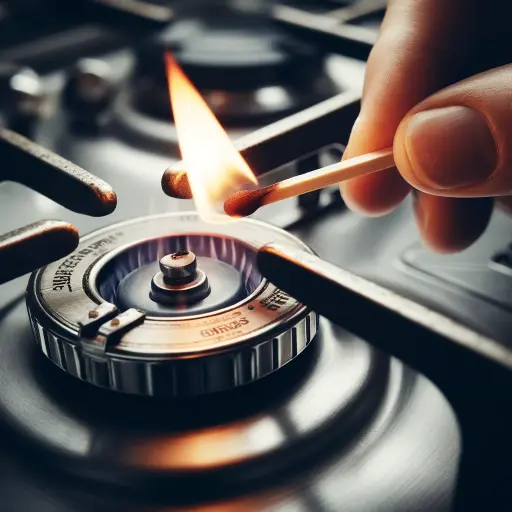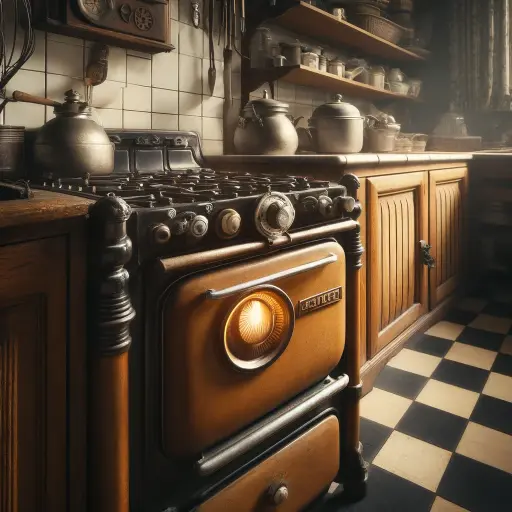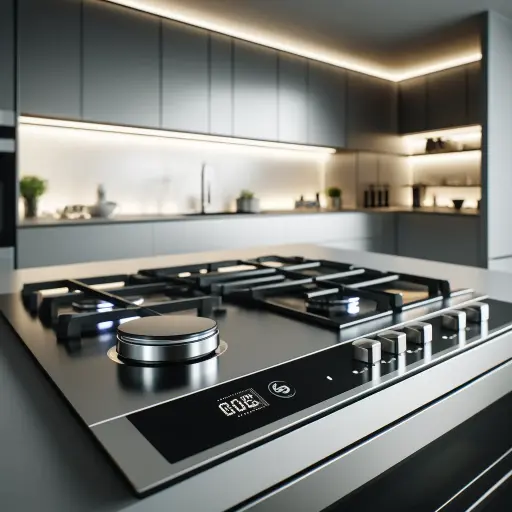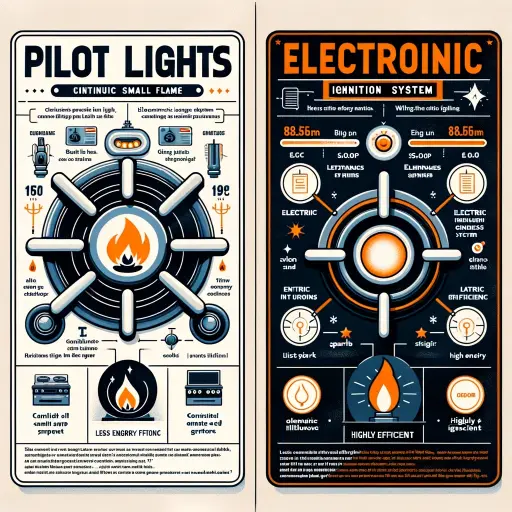What is a Pilot Light on Gas Stove and How It Works?
Updated: 26 Apr 2024
426
Imagine if you had a flashlight that was always ready to light up when you needed it. That’s what a pilot light does for your gas stove. But not all stoves have this feature anymore. Some have clever electronic systems that do the job differently.

Understanding what is a Pilot Light on a Gas Stove and knowing how it works is important for using your stove safely.
In this article, we’ll take a close look at pilot lights on gas stoves. We’ll talk about why they matter and how they work. We’ll also explore other ways stoves can start, and whether it’s best to leave the pilot light on all the time. So, let’s get started and shed some light on this topic!
What is a Pilot Light on a Gas Stove?
A gas stove’s pilot light is like a little flame that stays on all the time. It’s a bit like a tiny torch that helps start the big flames when you want to cook.
The pilot light’s job is pretty important. It’s the starting point for the fire. When you turn on your stove, the gas flows, and the pilot light is there to light it up. It’s like the spark that sets things in motion.
Historical context: Prevalence in older stoves

Back in history of stoves, most stoves had pilot lights. It was the way things worked. These older stoves relied on this little flame to get things cooking. They didn’t have the fancy electronic systems we have today.
But, you see, times have changed. Newer stoves often use smarter electronic methods to get the flames going.
They don’t need a pilot light burning all the time. So, if you’ve got an older stove, chances are it has a trusty pilot light. If it’s a newer one, it might use a different way to get cooking. That’s the neat thing about progress!
2. Do All Gas Stoves Have Pilot Lights?
Not necessarily! Gas stoves come in two types: those with pilot lights and those without. Older models typically have pilot lights—a small, always-on flame ready to ignite the burners or stove eyes.
Newer stoves, however, use electronic ignition systems. They don’t require a constant flame and instead work their magic when you turn on a burner.

So, take a glance at your stove to see which type you have. It’s an easy way to know if you’re working with a traditional setup or a more modern, efficient one.
Pros and Cons of Gas Stove Pilot Lights
Pros of Pilot Light
Here are the pros of having a gas stove with a pilot light in simple terms:
- Reliable Starter: The pilot light is like a little helper that’s always ready. It quickly lights up the burners when you want to cook.
- Always Ready: Unlike other ignition methods, the pilot light is always on. You don’t need to worry about it not working when you need it.
- No Need for Electricity: Pilot lights don’t rely on electricity, so even if the power goes out, you can still cook on a gas stove with a pilot light.
- Familiar and Time-Tested: Many people are used to pilot lights. They’ve been around for a long time, so they’re a familiar and trusted way to start a gas stove.
- Keeps Areas Warm: In colder climates, the pilot light can give off a small amount of heat, which can be a cozy bonus.
Cons of Pilot Light Having Gas Stoves
Here are the cons of having a gas stove with a pilot light:
- Continuous Gas Usage: Pilot lights need a small amount of gas to stay lit all the time. This means they use up a bit of gas even when you’re not cooking, which can lead to higher gas bills.
- Less Energy Efficient: Compared to newer electronic ignition systems, pilot lights are less energy-efficient. They use gas constantly, which may not be as environmentally friendly.
- Potential Safety Concerns: If a pilot light goes out or isn’t burning properly, it can lead to a buildup of gas, which could lead to a gas stove explosion. Regular checks and maintenance are crucial for safety.
- Maintenance Needs: Pilot lights require periodic maintenance to ensure they’re burning correctly. This can involve cleaning and adjusting the flame, which may be an extra task for the stove owner.
- Not Suitable for All Environments: In very hot climates, a pilot light can add extra heat to the kitchen, which may not be ideal.
Exploring Gas Stove Ignition Methods: A Guide for Home Cooks
Before you know what is a pilot light on a gas stove , it is import to know ignition methods on gas stove. In fact kitchens, have evolved over the years, and one of the significant changes has been in their ignition methods.
Let’s take a closer look at the different ways gas stoves get those flames dancing.
A Pilot Lights on Gas Stove: The Traditional Torchbearers
Once upon a time, most gas stoves relied on pilot lights. These are tiny, ever-burning flames that act as the ignition source.
They’re like little soldiers, always on duty to light up the burners when needed. While reliable, they do have a minor drawback – they consume a small amount of gas continuously. So, they might not be the most eco-friendly option.
Electronic Ignition: The Modern Marvels
Enter the electronic ignition systems, the tech-savvy successors to pilot lights. These systems use a small electric spark or a hot surface to ignite the gas when you turn on a burner.
They’re like the superheroes of gas stove starters, springing into action only when called upon. This means they’re incredibly energy-efficient. They use gas only when you’re cooking, which can lead to savings on your gas bill.
Standing Pilots: A Bridge Between Old and New
Some modern stoves incorporate a hybrid approach, known as standing pilots. These are pilot lights that are only active when the stove is in use.
When you turn off the burners, the standing pilot goes out, conserving gas. It’s like a blend of tradition and modern efficiency.
Glow Bar Ignition: The Silent Starter
Another method gaining popularity is the glow bar ignition. It uses an electrically heated wire to ignite the gas. This system is quiet and efficient, making it a favored choice for many modern stoves.
Also Read: Can electric stoves explode?
Comparison Between Pilot Light and Electronic Ignition System

Here’s a comparison table between Pilot Light and Electronic Ignition System for gas stoves:
| Aspect | Pilot Light | Electronic Ignition System |
|---|---|---|
| Ignition Method | Continuous small flame | Electric spark or hot surface |
| Energy Efficiency | Less efficient (constant gas usage) | Highly efficient (gas used only when cooking) |
| Reliability | Generally reliable | Very reliable |
| Environmental Impact | Less eco-friendly (constant gas usage) | More eco-friendly (reduces gas consumption) |
| Maintenance | Requires occasional adjustment and cleaning | Low maintenance, rarely requires attention |
| Safety | Need to relight if flame goes out | No relighting required |
| Initial Cost | Generally lower | Slightly higher due to electronic components |
| Long-Term Cost | Slightly higher due to continuous gas usage | Lower due to reduced gas consumption |
| Availability in New Models | Less common in newer models | Standard in most newer models |
| Heat Output | Gives off a small amount of heat | No additional heat generated |
| Ease of Use | Easy to use and understand | Easy to use, similar to other appliances |
| Suitable Environments | All environments | All environments |
Converting to Electronic Ignition
Feasibility and Benefits of Converting from Pilot Light to Electronic Ignition
Thinking about upgrading your gas stove’s ignition system? It’s a smart move! Switching from a pilot light to an electronic ignition can bring several benefits.
Electronic ignitions are more energy-efficient, as they only use gas when you’re cooking. This can lead to savings on your gas bill in the long run. They’re also more reliable and require less maintenance compared to pilot lights, which can sometimes go out and need re-lighting.
Consultation with a Professional: Recommended Steps
Before diving into a conversion, it’s a good idea to consult with a professional. They’ll assess if your stove is compatible with an electronic ignition system.
They can also ensure the installation is done safely and according to local regulations. Trusting a pro ensures a smooth transition and peace of mind.
Safety Considerations
Proper Ventilation and Air Quality
Safety first! Ensuring proper ventilation in your kitchen is crucial. A well-ventilated space helps prevent the buildup of harmful gases. It also keeps the air fresh and pleasant while you’re cooking up a storm.
Monitoring for Gas Leaks
A keen nose can be a lifesaver. If you ever detect the smell of gas, it’s important to act fast. Turn off the gas supply, open windows for ventilation, and do not use any flames or electrical switches. Contact a professional immediately to inspect and fix any leaks. You should familiarize yourself with common gas stove issues to avoid any untoward situation.
Carbon Monoxide Concerns
Carbon monoxide is a colorless, odorless gas that can be produced by gas stoves. It’s essential to have a working carbon monoxide detector in your kitchen. This small device can alert you if levels become unsafe, giving you time to take action.
Soot and Maintenance Issues
Regular maintenance is key to a safe and efficient stove. Keep an eye out for any soot buildup, as this can be a sign of incomplete combustion. Cleaning your stove regularly ensures it functions properly and reduces the risk of any safety issues.
How to Relighting a Pilot Light on a Gas Stove
Step-by-step Guide for Safely Relighting a Pilot Light
If your stove has a pilot light and it goes out, don’t worry! Relighting it is easy. Follow these steps for a safe and hassle-free process:
- Locate the Pilot Light: Find the pilot light assembly, usually located near the burners. It’s a small, continuously burning flame.
- Turn the Knob to Pilot: Set the stove’s control knob to the “pilot” position. This position is usually marked on the knob or indicated in the stove’s manual.
- Ignite the Pilot Light: While holding down the control knob in the pilot position, use a long lighter or match to ignite the pilot flame. Continue to hold the knob for about 30 seconds to ensure the pilot light stays lit.
Troubleshooting Tips for Common Issues

Sometimes, pilot lights can be a bit finicky. If you’re having trouble keeping it lit or notice any unusual behavior, Here are three common troubleshooting issues with a pilot light:
Pilot Light Won’t Stay Lit
- Possible Causes: This could be due to a dirty or clogged pilot orifice, a weak thermocouple, or a malfunctioning gas valve.
- Troubleshooting Steps: Clean the pilot orifice carefully, ensure the thermocouple is properly positioned and functional, and check for any gas valve issues.
Pilot Light Flame is Yellow or Flickering
- Possible Causes: A yellow or flickering pilot light can be caused by dirt or debris in the burner orifice, improper air mixture, or insufficient gas flow.
- Troubleshooting Steps: Clean the burner orifice and ensure it’s clear of any obstructions. Adjust the air shutter to achieve the proper air-to-gas mixture. Check for any gas pressure issues.
Pilot Light Goes Out Frequently
- Possible Causes: This can occur due to a weak or faulty thermocouple, improper positioning of the thermocouple, or drafts near the appliance.
- Troubleshooting Steps: Ensure the thermocouple is correctly positioned in the flame and functioning properly. Check for any drafts in the area and address them if necessary. If the issue persists, the thermocouple may need replacement.
Should the Pilot Light Always Be On?
Addressing Safety Concerns
While pilot lights are reliable, they require extra attention to ensure safety. Adequate ventilation is crucial, and regular checks for gas leaks and soot buildup are recommended.
Modern Practices and Recommendations
In modern stoves, electronic ignition systems are the norm. They are more energy-efficient and eliminate the need for a continuously burning pilot light, promoting safety and energy savings.
Identifying if Your Gas Stove Has a Pilot Light
Visual Inspection of Stove Components
Check for a small, always-on flame near the burners. If it’s there, you have a pilot light. If not, your stove likely uses electronic ignition.
Consulting the Stove’s Manual or Manufacturer
When in doubt, refer to the manual or contact the manufacturer for precise information on your stove’s ignition system. It’s a reliable way to confirm the type you have.
Common Questions on Gas Stoves Having Pilot Lights
How Much Gas Does Pilot Light Use?
A pilot light on a gas appliance typically consumes a small amount of gas, approximately 600 to 900 BTUs per hour. While this is relatively low, it can accumulate over time if left on continuously.
Do Gas Ovens Have a Pilot Light?
Most modern gas ovens don’t have a pilot light. They utilize electronic ignition systems, which only ignite the gas when the oven is turned on. This is more energy-efficient. Older models may still use a pilot light for ignition.
Conclusion
To sum it up, not all gas stoves have pilot lights. Older ones often do, while newer models use electronic ignition for a more efficient start. Now you’re in the loop about which type of stove you’ve got. Thanks for hanging out and learning with me! Happy cooking!
References
- Should You Extinguish Your Gas Stove?
- Indoor Combustion and Asthma
- Gas stoves leak climate-warming methane even when they’re off
Please Write Your Comments